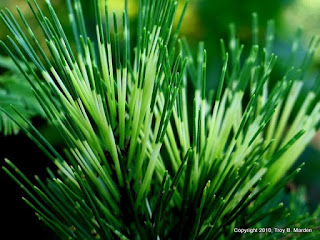Hi Everyone--This week I'm passing along a press release about the episode of Volunteer Gardener that will air in the Nashville viewing area on Nashville Public Television this coming Thursday evening, June 17, at 7:30 p.m. and will repeat at 9:30 a.m. on Sunday the 20th. We air statewide across Tennessee, but at different times in different viewing areas, so if you're in the Knoxville, Chattanooga, Memphis, Martin or Cookeville areas, you'll need to consult your local listings. For those of you who live outside of Tennessee, if the show becomes available on the internet, I will let you know.
As many of you know, two weeks after we filmed this episode back in March, Jackson & Perkins announced that they were filing for bankruptcy. Unfortunately, we do not know what that means for the 'Crescendo' rose at this time. Jackson & Perkins retail mail order business is undergoing re-organization, along with it's parent company Park Seed, but it is my understanding that the wholesale division, which includes all breeding and research, has been re-claimed by the bank. It is our belief at this time that since 'Crescendo' was set to be unveiled in the 2011 J&P catalog and the catalog/mail order division is being re-organized, that it is already in production fields and we will still see 'Crescendo' come to market next spring. I will let you know as we learn more.
As always, thanks for continuing to follow along with the blog. There is much, much more to come!
FOR IMMEDIATE RELEASE
Pictured: Troy Marden host of “Volunteer Gardener” with Crescendo rose hybridizer Keith Zary of Jackson & Perkins (photo by: Katherine Bomboy)
NASHVILLE MUSIC GARDEN’S LATEST ADDITION TO BE FEATURED ON NASHVILLE PUBLIC TELEVISION'S "VOLUNTEER GARDENER" THIS WEEK
The Crescendo Rose Honoring the Nashville Symphony is the First Rose to Recognize a Specific Symphony Orchestra
NASHVILLE, Tenn.--June 15, 2010--The Nashville Symphony was recently honored by Jackson & Perkins with a brand new rose variety, aptly named "Crescendo." It is the first rose to be named in honor of a specific symphony orchestra and the latest addition to the Nashville Music Garden. Tune in to "Volunteer Gardener" on Nashville Public Television (NPT-Channel 8) on Thursday, June 17 at 7:30 p.m. and catch host Troy Marden as he profiles this fragrant and beautiful rose. The show re-airs on Sunday, June 20 at 9:30 a.m. Marden was on hand for Crescendo’s star studded unveiling at the Schermerhorn Symphony Center in March along with country stars Barbara Mandrell, Pam Tillis and Brenda Lee and captured all the fun for the show.
"Jackson & Perkins has been creating some of the world's finest roses for more than 130 years and 'Crescendo' is the latest in a long line of rose masterpieces. It was an honor to interview Crescendo's creator, Dr. Keith Zary,” said Marden. “I hope everyone will tune in to 'Volunteer Gardener' to see the Nashville Music Garden’s newest rose unveiled on the show!"
"Volunteer Gardener" also airs across Tennessee on select PBS stations including Knoxville, Chattanooga, Memphis, Martin and Cookeville (check local listings for show times).
About Crescendo:
Pat Bullard, a LifeWorks trustee and founder of the Nashville Music Garden (Located at the corner of Fourth Avenue and Demonbreun in the Hall of Fame Park just across the street from the Schermerhorn Symphony Center) along with Sam Jones and the Nashville Rose Society approached hybridizers Jackson & Perkins with their desire to honor the Nashville Symphony, regarded as one of the most creative and innovative orchestras in the nation today. The Crescendo is a fragrant cream and pink blend hybrid tea rose bred from two award-winning parents, "Gemini" and "New Zealand." The exhibition quality rose was developed by hybridizer Keith Zary.
Crescendo will debut for purchase in the Spring 2011 Jackson & Perkins retail catalog. For information about the Nashville Music Garden, visit www.NashvilleMusicGarden.com and for information about the Nashville Rose Society, visit www.NashvilleRoseSociety.com.
About NPT:
Nashville Public Television is available free and over the air to nearly 2.2 million people throughout the Middle Tennessee and southern Kentucky viewing area, and is watched by more than 600,000 households every week. The mission of NPT is to provide, through the power of traditional television and interactive telecommunications, high quality educational, cultural and civic experiences that address issues and concerns of the people of the Nashville region, and which thereby help improve the lives of those they serve. For more information, visit www.wnpt.org.


























